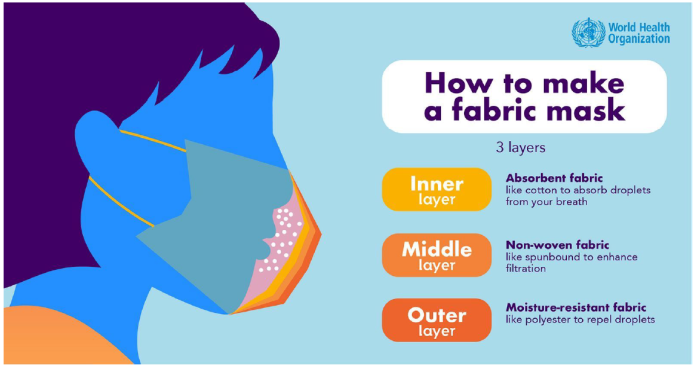
WHO recommendations on mask use by health workers, in light of the Omicron variant of concern: WHO interim guidelines, 22 December 2021
Mask management
For any type of mask, appropriate use, storage, cleaning or disposal are essential to ensure that they are as effective as possible and to avoid any increased risk of transmission. Adherence to correct mask management practices varies, reinforcing the need for appropriate messaging [115].
WHO provides the following guidance on the correct use of masks:
•Wash hands thoroughly before putting on the mask.
•Inspect the mask for tears or holes, and do not use a damaged mask.
•Place the mask carefully, ensuring it covers the mouth and nose, adjusts to the nose bridge and tie it securely to minimize any gaps between the face and the mask. If using ear loops, ensure these do not cross over as this widens the gap between the face and the mask.
•Avoid touching the mask while wearing it. If the mask is accidentally touched, wash hands thoroughly.
•Remove the mask using the appropriate technique. Do not touch the front of the mask; rather, untie it from behind.
•Replace the mask as soon as it becomes damp with a new, clean and dry mask.
•Either discard the mask or place it in a clean plastic resealable bag where it is kept until it can be washed and cleaned. Do not store the mask around the arm or wrist or pull it down to rest around the chin or neck.
•Wash hands immediately after discarding a mask.
•Do not reuse single-use masks.
•Discard single-use masks after each use and properly dispose of them immediately upon removal.
•Do not remove the mask to speak.
•Do not share your mask with others.
•Wash fabric masks in soap or detergent and preferably hot water (at least 60° Centigrade/140° Fahrenheit) at least once a day. If it is not possible to wash the masks in hot water, then wash the mask in soap/detergent and room-temperature water, followed by boiling the mask for 1 minute.
•A mask should be changed to a clean mask at least once daily.
Practical Info
For information on assessing and improving indoor ventilation, please see WHO’s Roadmap to improve and ensure good indoor ventilation in the context of COVID-19.
Practical considerations for policy-makers:
The potential advantages of mask use by healthy people in the general public include:
•reduced spread of potentially infectious aerosols or droplets from exhaled breath, including from infected people before they develop symptoms [15];
•encouraging concurrent transmission prevention behaviours such as washing hands and not touching the eyes, nose and mouth [16][17][18]; and
•preventing transmission of other respiratory illnesses such as tuberculosis and influenza and reducing the burden of these diseases during the pandemic [19].
The potential disadvantages of mask use by healthy people in the general public include:
•headache and/or breathing difficulties, depending on the type of mask used [12];
•development of facial skin lesions, irritant dermatitis or worsening acne when used frequently for long hours [13][20];
•difficulty with communicating clearly, especially for persons who are deaf or have poor hearing or use lip reading [21][22];
•poor compliance with mask-wearing, in particular by young children [24][25][26][27];
•waste management issues; improper mask disposal leading to increased litter in public places and environmental hazards [28]; and
•further disadvantages for, or difficulty wearing masks by, certain members of the population, especially: children;
Strong recommendation for , Moderate certainty evidence
In settings where there is community or cluster transmission of SARS-CoV-2, irrespective of vaccination status or history of prior infection, wearing a well-fitting mask* that covers the nose and mouth is recommended for the general public when interacting with individuals who are not members of their household:
•in indoor settings where ventilation is known to be poor or cannot be assessed, or the ventilation system is not properly maintained, regardless of whether physical distancing of at least 1 metre can be maintained1;
•in indoor settings that have adequate ventilation if physical distancing of at least 1 metre cannot be maintained; or • in outdoor settings where physical distancing of at least 1 metre cannot be maintained.
Mask types include: • reusable, non-medical masks that comply with the ASTM F3502 standard or CEN Working Agreement 17553, or a non-medical mask meeting WHO essential parameters (see practical info for more information).; • disposable medical masks, complying with medical mask standards EN 14683 Type I, ASTM F2100 Level 1, YY/T 0969, YY 0469 (or equivalent) if the availability of medical masks meeting minimum performance criteria for health workers has been assured; • if the above options are not available, other types of well-fitting non-medical masks including homemade multilayered masks are an acceptable option (according to local policies).
1 Physical distance should be increased beyond 1 metre whenever feasible.
Please refer to WHO Guideline here




















